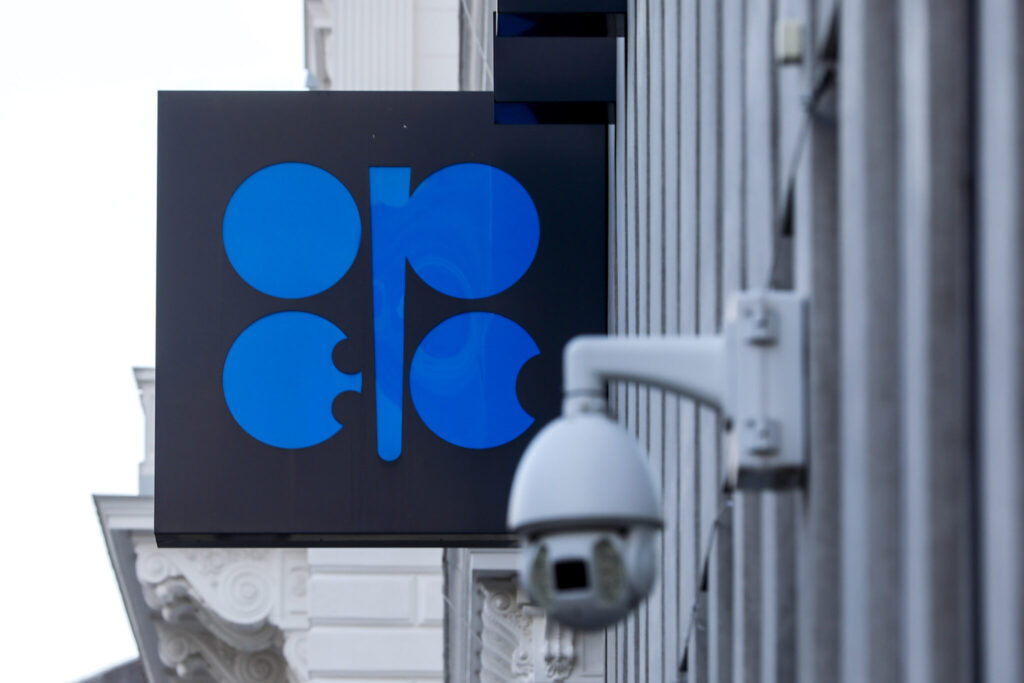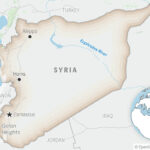OPEC+ oil producers on Thursday agreed to output cuts approaching 2 million barrels per day (bpd) for early next year led by Saudi Arabia rolling over its current voluntary cut. Saudi Arabia, Russia and other members of OPEC+, who pump more than 40% of the world’s oil, are holding a virtual meeting on Thursday to discuss 2024 output amid concerns the market faces a potential surplus.
Quick Read
- OPEC+ Output Cut Agreement: OPEC+ oil producers, including major players like Saudi Arabia and Russia, have agreed to cut oil production by nearly 2 million barrels per day in early 2024. This decision is part of ongoing efforts to stabilize the market and support oil prices.
- Current Output and Market Influence: OPEC+, which controls over 40% of global oil output, is currently producing around 43 million barrels per day. This production already includes cuts of about 5 million barrels per day.
- Saudi Arabia’s Role: Saudi Arabia will maintain its voluntary cut of 1 million barrels per day, which has been in effect since July.
- Russia’s Contribution: Russia will reduce its output by 500,000 barrels per day, with other OPEC+ members contributing additional cuts.
- Impact on Oil Prices: Brent crude futures have risen, reflecting market expectations of the OPEC+ decision to reduce output.
- Discussion on 2024 Outlook: The focus on output reduction is due to concerns about potential market surplus and weaker economic growth in 2024, coupled with expectations of a supply surplus.
- International Energy Agency’s Forecast: The IEA predicts a slowdown in demand growth for 2024, citing factors like energy efficiency and structural changes.
- Challenges in Reaching Agreement: The decision to cut output faced difficulties, including disagreements over quotas for African producers, leading to a delayed OPEC+ meeting.
- Brazil Joins OPEC+: In a significant move, Brazil will join OPEC+ in January, integrating a rapidly growing oil producer into the alliance.
- Global Economic Context: The output cuts come amid a weakening global economy and concerns about oil oversupply, with Brent crude prices staying in the low-to-mid-$80 range.
- Implications for U.S. Consumers: Lower oil prices have led to a decrease in U.S. gas prices, but they remain higher than at the start of President Joe Biden’s term.
- U.S. Production and Global Market: U.S. oil production has been increasing, potentially reducing OPEC’s influence over global oil supplies.
- Geopolitical Factors: The ongoing conflict between Israel and Hamas has not significantly impacted oil supply flows, according to the IEA..
The Associated Press has the story:
OPEC+ agrees oil output cuts approaching 2 million barrels per day
Newslooks- LONDON (AP)
OPEC+ oil producers on Thursday agreed to output cuts approaching 2 million barrels per day (bpd) for early next year led by Saudi Arabia rolling over its current voluntary cut.
Saudi Arabia, Russia and other members of OPEC+, who pump more than 40% of the world’s oil, are holding a virtual meeting on Thursday to discuss 2024 output amid concerns the market faces a potential surplus.
Their output of some 43 million bpd already reflects cuts of about 5 million bpd aimed at supporting prices and stabilizing the market.
OPEC+ sources said the latest agreement would involve cuts approaching 2 million bpd including Saudi Arabia extending a voluntary cut of 1 million bpd it has had in place since July.
Russia will cut 500,000 bpd and others will also contribute cuts, one source said.
Benchmark Brent crude futures were up 1.2% to above $84 a barrel at 1526 GMT on Thursday, on track for a third day of gains on expectations of fresh cuts from OPEC+.
RBC Capital Markets analyst Helima Croft earlier said that Saudi Arabia, which began its additional voluntary 1 million bpd in July, would not want to shoulder additional cuts alone.

“We could envision a scenario where Russia and Saudi Arabia roll over their cut through the first quarter of 2024 and assemble a coalition of the willing individual producers prepared to make voluntary adjustments,” she added.
The focus is on lower output with prices down from near $98 in late September and concerns brewing over weaker economic growth in 2024 and expectations of a supply surplus.
The International Energy Agency (IEA) this month forecast a slowdown in 2024 demand growth as “the last phase of the pandemic economic rebound dissipates and as advancing energy efficiency gains, expanding electric vehicle fleets and structural factors reassert themselves.”
Yet OPEC+ sources this week said discussions had been proving difficult, as evidenced by the group postponing their meeting which was scheduled for Nov. 26. Sources said the delay was sparked by disagreement over output quotas for African producers.
The OPEC+ meeting coincides with the opening of the United Nations’ COP28 climate summit being hosted by OPEC member the United Arab Emirates.
Saudi Arabia will extend a cut in the amount of oil it sends to the world after a series of reductions by members of the OPEC+ alliance of major producing countries failed to prop up prices.
That’s been a good thing for U.S. drivers, who have been able to fill their gas tanks for less money in recent months. But it’s bad news for OPEC+ countries whose oil income bolsters their economies and who have faced setbacks in pushing prices higher despite initial fears that the Israel-Hamas war could affect oil flows.
The Saudi Energy Ministry said in a statement on its website that its voluntary cut of 1 million barrels per day will stay in place through the first three months of next year.
It was announced after rest of the OPEC oil cartel and allied nations like Russia met in an online meeting about global oil production.
The OPEC+ coalition announced that Brazil will join the bloc in January, bringing one of the world’s fastest-growing oil producers into the alliance.The OPEC oil cartel led by Saudi Arabia and allied producers including Russia will try to agree Thursday on cuts to the amount of crude they send to the world, with prices having tumbled lately despite their efforts to prop them up.
That’s been a good thing for U.S. drivers, who have been able to fill their gas tanks for less money in recent months and whose costs at the pump can be sensitive to moves by the OPEC+ coalition. But it’s bad news for OPEC+ countries whose oil income props up their economies and who have faced setbacks in keeping prices up despite initial fears that the Israel-Hamas war could affect oil flows.
Now, they are struggling to come to a consensus on production cuts, analysts say, on the same day the U.N. climate conference kicks off in the United Arab Emirates, an OPEC member.
The group postponed its meeting originally set for Sunday by four days, indicating that a new agreement will prove to be challenging, said Jorge Leon, senior vice president of oil market research for Rystad Energy.
“Despite the challenges, we still expect OPEC+ to reach an agreement to reduce production,” he said in an analyst note. That’s because “every member country acknowledges the need to reduce output to support prices into 2024.”
The question is how to split it among the 23 member countries, some of whom already accepted lower production targets at the last OPEC+ meeting in Vienna in June.
Another big question is whether Saudi Arabia and Russia will extend their additional voluntary cuts of 1 million barrels per day and 300,000 barrels per day, respectively, into 2024.
Russia wants more oil revenue as it faces Western sanctions but seeks to pour energy earnings into its war chest against Ukraine. The Saudis have to earn nearly $86 per barrel to meet their planned spending goals, according to the latest estimate from the International Monetary Fund.
The Saudis are trying to fund an ambitious overhaul of the kingdom’s economy, reduce its dependence on oil and create jobs for a young population.
But the international benchmark Brent crude has stayed in the low- to mid-$80 range in recent weeks, reflecting concerns about oversupply in a weakening global economy, which could weigh on the thirst for oil for travel and industry.
Brent rose 68 cents to $83.56 a barrel on Thursday, while U.S. crude climbed 62 cents to $78.48 a barrel in electronic trading on the New York Mercantile Exchange.
Lower oil prices have allowed U.S. gas prices to fall or stay steady since Sept. 19, AAA said. Gas is averaging just below $3.25 a gallon, the motor club said, down about 7% from a month ago.
But that’s still higher than when President Joe Biden took office in January 2021, when prices were averaging about $2.40 a gallon. High inflation has been a political challenge for Biden going into the 2024 election, prompting him to say Monday that efforts to improve supply chains and reduce price pressures are a priority.
White House national security spokesman John Kirby declined to address the possibility of OPEC+ reducing oil production.
“The president is going to keep focusing, as he has been, on a healthy global market that’s properly balanced and that can continue to bring the price of gasoline down here in the United States,” Kirby told reporters at a briefing Monday.
U.S. oil production has hit records as OPEC+ has cut back, with producers outside the group expected to keep leading global growth in oil supply next year, the International Energy Agency said in its November oil report.
For instance, daily production in the U.S. averaged 13 million barrels a day in August, an increase of more than 1 million barrels from a year ago, according to the latest monthly figures from the U.S. Energy Information Administration.
Now, the risk is growing that Saudi Arabia’s production cuts could reduce OPEC’s influence over oil supplies as other countries boost their output.
“The kingdom is balancing the desire to keep prices high by limiting supply with the knowledge that doing so will lead to a further drop in overall market share,” Leon said.
Meanwhile, fears the conflict between Israel and Hamas might spread throughout the region, creating a shock to the oil market, have not materialized, with the IEA noting that “there has been no material impact on oil supply flows from the war.”






